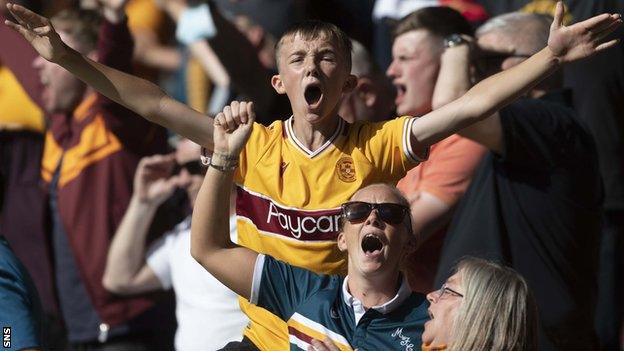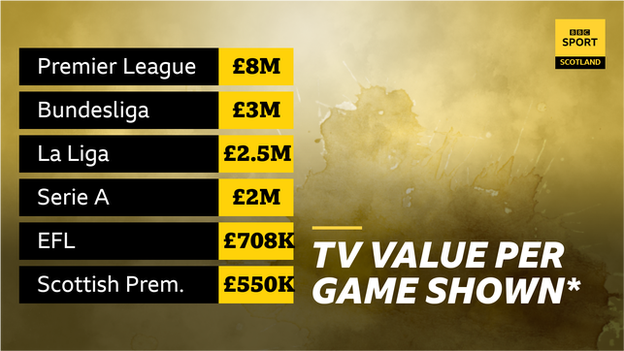Scottish Premiership: Introducing the best small league in Europe
- Published

Back in September, Hibernian owner Ron Gordon called the Scottish Premiership "one of the most exciting small leagues in Europe".
It is that belief which has fuelled the move by his club - plus Hearts, Aberdeen, Dundee United, and Dundee - to commission Deloitte to review the SPFL's stewardship of the competition.
Those top-tier clubs - four of whom are either American-owned or influenced by US practices - think the league is not attracting enough investment relative to what it offers. And Deloitte agree, concluding that broadcast revenues could swell to as much as £50m per year.
Gordon says "many" of the country's clubs agree so, if the five get their way, what might Scottish football look like?
Shouting louder about the league's uniqueness
Hibs, Dundee United and Dundee have American owners, while Aberdeen chairman Dave Cormack is based in Atlanta.
They have experience of the US approach to sports, where franchises are marketing behemoths, generating millions of dollars in revenue through a collaborative approach.
These owners - as well as many fans in Scotland - feel the Scottish Premiership's strengths are not trumpeted enough by those in charge. The SPFL has no central marketing budget, with clubs left to plough their own furrow.
"What do we want to be? What is our vision? I don't know what the vision is. We don't have a branding strategy," Cormack said last year.
One of the frustrations is the fact the league's raw passion, frantic nature, and head-wrecking off-field drama is underplayed in the increasingly commercial and sterile world of some of Europe's other major leagues.
Gordon believes that point of difference needs to be made clearer in order to raise central revenues from £27m per year, up to at least £50m in the next five years.
"It's authentic, real, very passionate," he told BBC Scotland. "When you look at some of the best things in Scottish football, we have attendance and social engagement among the best in Europe, but that doesn't always translate to the outsider.
"I don't think you would find as exciting a league at the scale of Scotland anywhere else in Europe. The energy in Scotland is unique. We need to capitalise on that."
Getting more fans in grounds for longer
More people go to watch football in Scotland each week than anywhere else in Europe on a per-capita basis, but there is a belief that attendances - and TV audience figures - can grow further.
Again drawing from their experiences in America, the clubs believe the matchday experience can be enhanced.
Alcohol has been banned in football grounds since the 1980 Scottish Cup final riot and some want to lobby the Scottish government to have that overturned.
Rather than just turn up for the 90 minutes and leave again, they want fans to spend more time - and money - at the ground and enjoy a more sociable experience.
United owner Mark Ogren has previously referred to the 'tailgating' culture at US Sports, where supporters can spend several hours at a stadium before a match.
"The whole mission with the Deloitte initiative is they need to come back to us with actionable items, not, 'this is the problem'," said Gordon.
Prising more money from broadcasters
It's not just about bums on seats, clubs also want to fight for a better television product.
Sky Sports paid around £160m for exclusive rights to show 48 Premiership games per season (plus six play-off matches) from last year until 2025. They outbid BT Sport, who had attracted praise for their geographical reach and in-depth coverage.
Aberdeen chief Cormack criticised Sky, external last season for a promo that went out before their game with Celtic in which they showed 22 goals the Glasgow side had scored in recent meetings between the clubs.
It played into accusations that Sky sell their coverage to UK viewers based on the Old Firm - especially the derbies - rather than promoting the league as a whole.
However, Sky were the only ones to make an offer the SPFL deemed acceptable and the price paid per game is a lot higher than many comparable leagues in Europe, who attract greater TV investment by selling more matches.
So do the five clubs want more games sold for more money? Or are they happy to try to protect season-ticket sales by keeping the number of games lower?
As a UK broadcaster, Sky understandably prioritise the lucrative Premier League, for which they pay around £8m per game.
"If you take four Old Firm games alone that's the equivalent of £30m of value based on the Premier League payment terms," Rangers managing director Stewart Robertson said in July. "But the SPFL as a league is only getting £25m for 48 league games? How can we say we've sold that well?"
Hibs owner Gordon - who made his money in sports rights in the United States - met Sky in London late last year as part of his pitch to create a stronger brand, citing broadcasting as "one of the most important" aspects.

*Reported figures for the average price paid by broadcasters per game in European leagues
Fewer senior clubs & a closed shop?
As Scotland's biggest clubs look for reform, there will inevitably be consequences for those further down the pyramid.
The SPFL was formed in 2013 after the merger of the SPL and SFL formed one 42-team organisation. But is it under threat? Gordon, Hearts chair Ann Budge, and Cormack have all previously suggested that number of clubs - with a range of divergent needs and interests - is too many.
As Cormack put it last year: "To have clubs, good clubs who are maybe second division but with a few hundred fans, versus clubs who have tens of thousands of fans, it's just so difficult. It's impossible to get agreement."
The different priorities of full-time and part-time clubs was laid bare during the first Covid-19 shutdown.
The former desperately wanted to get back playing and were willing to invest in testing, while smaller clubs were hamstrung by cost to the point it was not worth restarting. It led to a different approach among the divisions.
Gordon and others have floated the idea of keeping the current pyramid, but allowing the bigger clubs to go their own way in terms of decision making, while allowing the increased revenue to trickle down in the same way it currently does.
"My sense is that somewhere in the middle maybe 24 [clubs] or something like that," he told The Athletic last month. "You could still keep the pyramid going, but the focus would be on the full-time, professional clubs that can really grow the game.
"Ultimately what happens at the top, trickles down to the smaller clubs. So you can still keep all the payments and residuals flowing down."
The concern for some fans will be the prospect of a US-style closed shop, where franchises are protected from relegation, which gives greater certainty to owners and investors. That may suit some in boardrooms, but it would be an anathema to supporters across the country.
More money... and perhaps profit?
Football clubs are not hugely profitable, but they are a relatively cheap investment. There are not many industries where you can buy such well-established businesses with such a strong identity for so little.
The idea, then, is if revenues can be maximised and the league's appeal widened, majority shareholders can at some point cash in on their purchase later down the line after value has been added.
"This isn't a hobby for us and we expect to make money long-term," said United owner Ogren when taking control in December 2018.
The problem for the five clubs will be getting their way. The Deloitte review has been discussed by the SPFL board but now it becomes a political mission to convince the majority of the 42 clubs reform is in their best interests.
As has been proven time and again in Scottish football, getting consensus is the most challenging task of all.